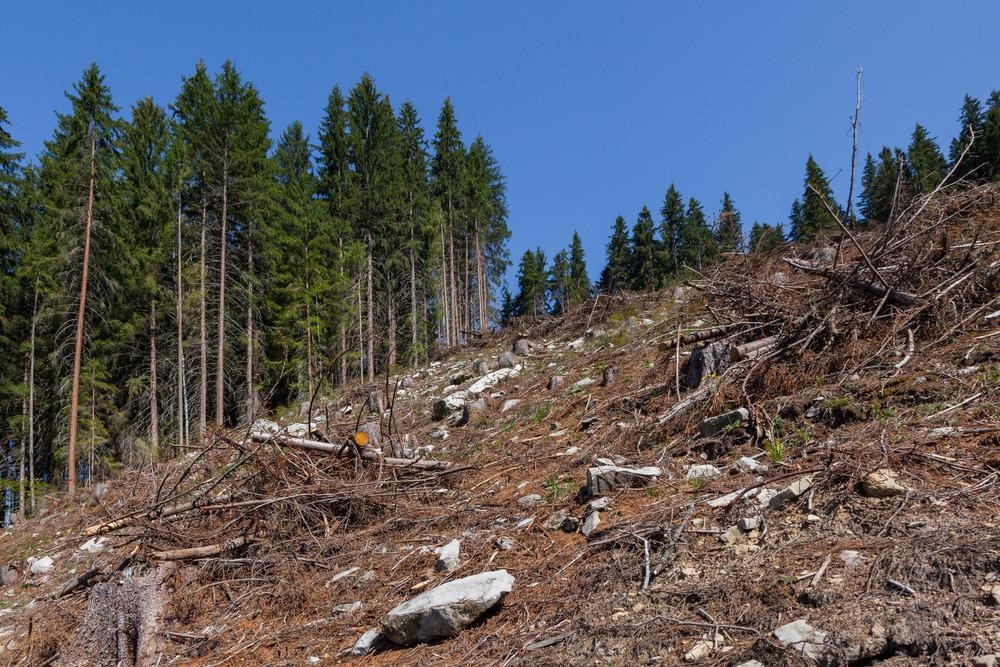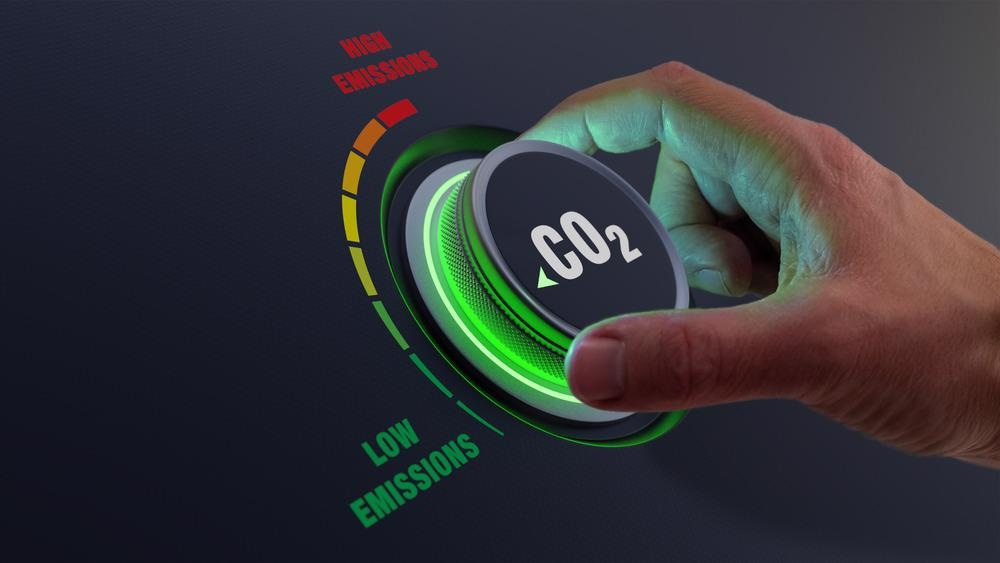All life on earth has an impact on its environment, from bacteria to giant redwood trees. Humans have had a more profound impact on the planet in recent years than any other species. Since the industrial revolution, the detrimental effects we have been having on our planet have been happening so fast and on such a large scale that we haven’t given it time to heal and regenerate.
Our use of energy and our impact on the environment through urbanization, deforestation, acidification of the oceans, and agricultural processes have increased at an alarming rate since 1950. Many of these processes are underpinned by biochemistry and novel research is being done into how it can also be used to provide solutions to the mounting problems.

Image Credit: Serhii Moiseiev/Shutterstock.com
Environmental degradation
The number of resources being consumed by the human population outpaced the earth’s ability to regenerate them in a year in 2017. Climate change, the destruction of the biosphere, agricultural impact, and overuse of fertilizer affecting the oceans are the most pressing problems that need to be tackled to ensure our life on earth is sustainable.
In 70 years, the amount of nitrogen entering the world's oceans due to fertilizer has increased fourfold. This is due to increased pressure on food production and so depletion of natural minerals. This leads to the acidification of the marine environment, culling fish populations and causing coral reef bleaching. This is not only having a massively detrimental effect on marine wildlife but also impacts the human food supply.
Although concerted efforts have been made to slow some of the processes, the rate at which other forms of environmental degradation are worsening is increasing at an alarming rate.
Role of biochemistry
The way the human species use the resources at their disposal affects the delicate processes and cycles that underpin the basis of life on earth. The four spheres that make up these processes are all founded in biochemistry and any change to them greatly affects the chemical composition of the planet.
The lithosphere, otherwise known as the geosphere, contains nonrenewable minerals and nutrients needed for plant growth. It also contains fossil fuels such as coal, natural gas, and oil as well as metals and gemstones. Humans mine these valuable resources, disrupting the composition of the lithosphere, and causing an increase in erosion and sedimentation by clearing land for agricultural and housing purposes.
The atmosphere is constantly modified by organisms consuming and expelling carbon dioxide, oxygen, and other chemical compounds. The burning of fossil fuels releases harmful chemicals such as carbon dioxide and methane that upset the balance in the atmosphere and alter the temperature and air quality of the planet.
The Biosphere is made up of all the living organisms on the planet and how they interact with each other. The changes humanity is making to the planet affects all other life and has caused the rate of extinction to increase by a factor of 100 compared to previous studies.
All the water present on earth makes up the hydrosphere and it is affected by the organisms that rely on it. Humans upset this balance by altering the natural flow of surface waters, mining precious groundwater, draining wetlands, and destroying ecosystems to use the land for agriculture. The disruption of the world's water system is due to the way humans have used and changed natural processes.
The chemical composition of these systems has been altered by humans either directly or indirectly. The massive increase in fertilizer use has caused a substantial increase in the levels of nitrogen present in the soil and water cycle. The increase in terrestrial nitrogen levels is also due to the by-products produced when burning fossil fuels.
The burning of fossil fuels is also responsible for the stark rise in carbon dioxide in the atmosphere and so for the alteration of the natural carbon cycle.
Novel Research
Although the situation is challenging, novel research is making impressive progress in tackling some of the issues. New technologies like fuel cells that provide clean and renewable energy and processes to reduce pollution from smokestacks are paving the way for a more sustainable economy.
One of the new technologies designed to tackle the production of carbon emissions is carbon capture and storage (CCS). It focuses on storing carbon produced by burning fossil fuels in stable geological configurations underground. The carbon could either be stored in structural traps or dissolved in a suitable liquid.
Another new technology hoping to tackle the production of carbon dioxide is the development of lithium-ion batteries using alternative production processes such as nitrogen-doped carbon. Nitrogen-doped carbon has the potential to produce batteries that charge faster, have a longer cyclability, and have higher capacity retention.
The production of sustainable active packaging is a popular research topic and a novel antimicrobial packaging material has been developed by Aytac et al. (2021). This packaging is biodegradable, sustainably produced, and possesses antimicrobial properties making it a desirable alternative to conventional packaging.

Image Credit: NicoElNino/Shutterstock.com
Future visions
The current use of the world's resources is unsustainable and massive changes must be implemented to protect humanity and the planet. Although the pressures of providing for an ever-increasing population are challenging, how housing, food, and energy are produced needs to be updated.
The destruction of fertile soils, the water cycle, and our planet’s atmosphere is harming both humanity and all other organisms on earth. The research being done into sustainable technologies is promising but a larger, concerted effort by the policymakers of the world is needed.
References:
- Chu, E. and Karr, J. (2013) Environmental Impact, Concept and measurement of. Encyclopedia of Biodiversity (Second Edition), 278-296. https://doi.org/10.1016/B978-0-12-384719-5.00253-7
- Milman, O. (2015). Rate of Environmental Degradation puts life on Earth at Risk Says Scientists [Online] Our World. Available at: https://ourworld.unu.edu/en/rate-of-environmental-degradation-puts-life-on-earth-at-risk-say-scientists (Accessed on 30 December 2021)
- Paris, S. (2018). Environmental degradation [Online] World Atlas of Global Issues. Available at: https://espace-mondial-atlas.sciencespo.fr/en/topic-resources/article-5A01-EN-environmental-degradation.html (Accessed on 30 December 2021)
- Patnaik, K., Badam, R., Peng, Y., Higashimine, K., Kaneko, T. and Matsumi, N. (2021) Extremely fast charging lithium-ion battery using bio-based polymer-derived heavily nitrogen doped carbon. Chemical Communications. 57, 13704-13707. https://doi.org/10.1039/D1CC04931C
- Tyne, R. L., Barry, P. H., Lawson, M., Byrne, D. J., Warr, O., Xie, H., Hillegonds, D. J., Formolo, M., Summers, Z. M., Skinner, Z. M., Eiler, J. M. and Ballentine, C. J. (2021). Rapid microbial methanogenesis during CO2 storage in hydrocarbon reservoirs. Nature. 600, 670-674. https://www.nature.com/articles/s41586-021-04153-3
- (Aytac, Z., Xu, J., Pillai, S., Eitzer, B., Xu, T., Vaze, N., Ng, K., White, J., Chan-Park, M., Luo, Y. and Demokritou, P. (2021) Enzyme- and Relative Humidity-Responsive Antimicrobial Fibres for active Food Packaging. American Chemical Society. 13 (42), 50298-50308. https://doi.org/10.1021/acsami.1c12319)
Further Reading
Last Updated: Mar 31, 2022